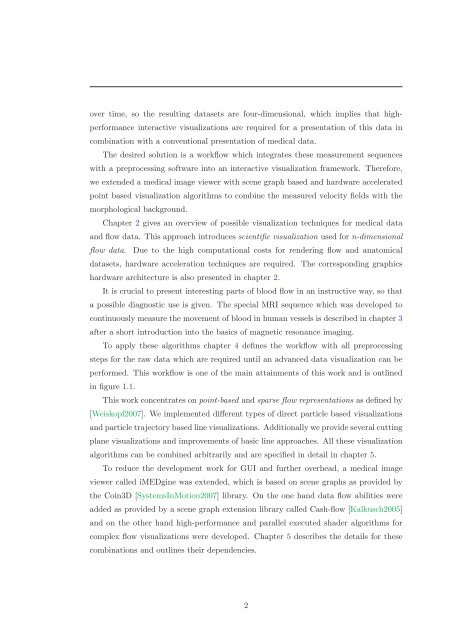Master's Thesis - Studierstube Augmented Reality Project - Graz ...
Master's Thesis - Studierstube Augmented Reality Project - Graz ...
Master's Thesis - Studierstube Augmented Reality Project - Graz ...
Create successful ePaper yourself
Turn your PDF publications into a flip-book with our unique Google optimized e-Paper software.
over time, so the resulting datasets are four-dimensional, which implies that highperformance<br />
interactive visualizations are required for a presentation of this data in<br />
combination with a conventional presentation of medical data.<br />
The desired solution is a workflow which integrates these measurement sequences<br />
with a preprocessing software into an interactive visualization framework. Therefore,<br />
we extended a medical image viewer with scene graph based and hardware accelerated<br />
point based visualization algorithms to combine the measured velocity fields with the<br />
morphological background.<br />
Chapter 2 gives an overview of possible visualization techniques for medical data<br />
and flow data. This approach introduces scientific visualization used for n-dimensional<br />
flow data. Due to the high computational costs for rendering flow and anatomical<br />
datasets, hardware acceleration techniques are required. The corresponding graphics<br />
hardware architecture is also presented in chapter 2.<br />
It is crucial to present interesting parts of blood flow in an instructive way, so that<br />
a possible diagnostic use is given. The special MRI sequence which was developed to<br />
continuously measure the movement of blood in human vessels is described in chapter 3<br />
after a short introduction into the basics of magnetic resonance imaging.<br />
To apply these algorithms chapter 4 defines the workflow with all preprocessing<br />
steps for the raw data which are required until an advanced data visualization can be<br />
performed. This workflow is one of the main attainments of this work and is outlined<br />
in figure 1.1.<br />
This work concentrates on point-based and sparse flow representations as defined by<br />
[Weiskopf2007]. We implemented different types of direct particle based visualizations<br />
and particle trajectory based line visualizations. Additionally we provide several cutting<br />
plane visualizations and improvements of basic line approaches. All these visualization<br />
algorithms can be combined arbitrarily and are specified in detail in chapter 5.<br />
To reduce the development work for GUI and further overhead, a medical image<br />
viewer called iMEDgine was extended, which is based on scene graphs as provided by<br />
the Coin3D [SystemsInMotion2007] library. On the one hand data flow abilities were<br />
added as provided by a scene graph extension library called Cash-flow [Kalkusch2005]<br />
and on the other hand high-performance and parallel executed shader algorithms for<br />
complex flow visualizations were developed. Chapter 5 describes the details for these<br />
combinations and outlines their dependencies.<br />
2





